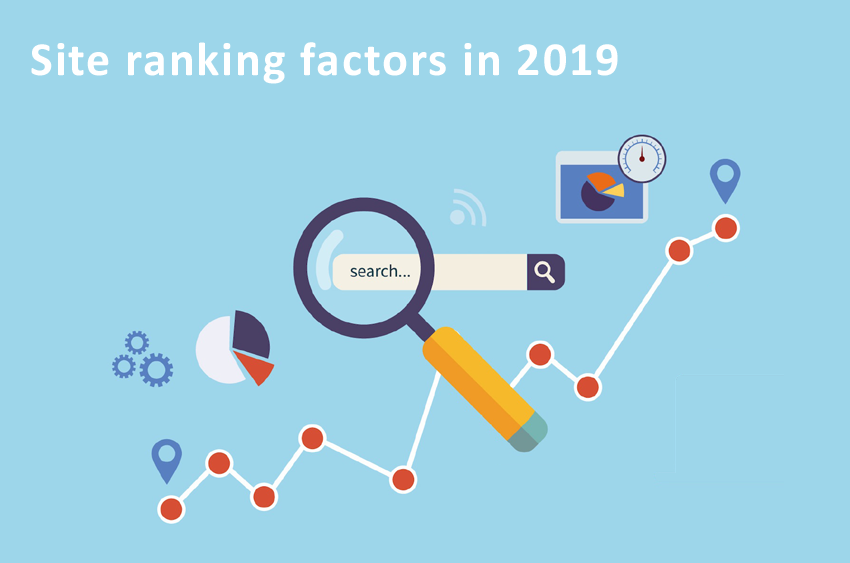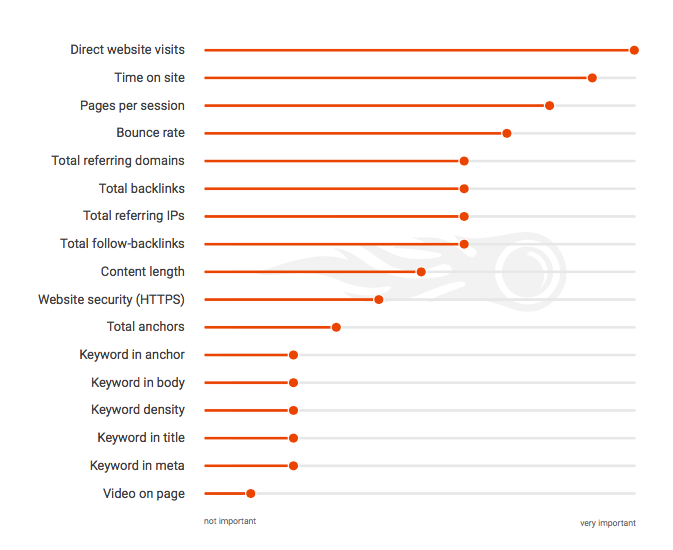Site ranking factors are the search engine's estimated parameters, which are used to calculate the significance of the site's pages and determine their position in organic ranking. The largest search engines today operate on thousands of such factors.

In this study, we tried to collect all the major ranking factors that are relevant at the moment. At the end, a separate rating of parameters for Google is presented, which was built according to the own methodology of Hannah Paxton.
Main categories of factors
- Commercial factors – the utility and convenience for the client.
- Are there contacts on the site for communication, location, product delivery terms, additional communication methods, the ability to call back, free / paid delivery? Due to these factors, it is determined how much the user trusts the site and is ready to perform the target action.
- Text factors – the presentation of content, its correctness, completeness and relevance.
- Reference factors – the quality of links that lead to the site, internal linking of the site.
- In recent years, the importance of links is increasingly decreasing due to the fact that the weight of this factor flows to other factors (behavioral, commercial, etc.).
- Behavioral factors – how much the user likes the site and how much time he spends on it.
- Trust factors – the degree of confidence in the site.
- The trust can be attributed to the age of the site, direct transitions to the site, the average position of the site pages, the number of sessions and the number of actions, the diversity of site traffic, etc. Link links – sites that link to you and their quality.
Detailed description of ranking factors
1. Availability of mobile version of the site / responsive design
- Currently, 50-55% of Internet users use mobile devices to search for information (for comparison, in 2014 this segment was 32-37%).
- 27% of Internet users are classified as "mobile only". These are users who access the Internet only from mobile devices.
- Adaptive site layout is better than a separate subdomain for the mobile version, because the reference mass is still important for ranking, and it’s better if the links lead to one domain.
2. High speed site loading and high-quality hosting
- According to information from representatives of Google, the impact of site loading speed on the ranking is only about 1%. However, it should be borne in mind that with an increase in download speed of only 0.4 seconds, the number of transitions drops by 76%, which in turn negatively affects the viewing depth and lowers the popularity of the resource as a whole.
- Working on the acceleration of the site, setting up the server, debugging functions, you can directly increase the conversion and increase sales.
- The more accessible and stable the server is, the more actively the pages get into the Google and Yandex index.
3. AMP pages for Google and turbo for Yandex
- The turbo pages from Yandex and AMP from Google are attempts to speed up page loading, even at low Internet connection speeds.
- The role of this technology will only increase, since there are no other alternative ways to dramatically increase the speed of downloading sites with a weak Internet.
- Benefits:
- The download speed increases, which in many factors improves the position in the issue (behavioral factor, decrease in failures, increase in the number of clicks, growth in popularity).
- Yandex claims an advantage in the speed of loading of turbo pages up to 15 times compared to adaptive versions of sites.
- Reduces the load on the server of your resource.
4. SSL certificate and HTTPS protocol
- In 2019, the transition to the HTTPS protocol for commercial sites is a prerequisite for successful development. Not only in terms of security, but also because of SEO promotion.
5. Traffic and direct visits to the site
- Direct traffic is most strongly correlated with positions in the organic issue. That is, if users go directly to the site, this is a good sign of the high authority of the site for search engines.
- User behavior on the site is also well matched with positions in organic. The factors "time spent on the site", "number of views", "bounce rate" appear to have an impact on positions (although Google denies their use due to the presence of "noise" in the samples and the lack of statistical confidence).
- Conclusion: increasing brand awareness is just as important as making SEO efforts. Branding your site.
6. Content and its quality
- Gone are the days of indiscriminate posting and posting incomprehensible articles. Today it is important to draw up a clear content plan for at least the next 2-3 months.
- In this regard, it is necessary to continuously work on expanding the semantic scope of the resource and constantly feed your site with new publications. This will provide improved visibility in organic search, increase search engine confidence, help build up the natural link mass and expand the permanent audience of your WEB resource.
- Fresh up-to-date content is more likely to be in search above obsolete pages.
7. Useless pages and doubles
- For example, Google really dislikes today automatically scaled pages with little unique content, and can punish the whole site for them, reducing its overall authority and position.
- Therefore, you need to try to make these pages as unique as possible, add text, perhaps some additional value, optimize. It is desirable, at least a little to pump the link. Tags or filter pages that have worked this way can bring a lot of traffic.
- It is necessary to identify on your site just different outdated, obsolete content, pages with falling or zero traffic (also called "zombie pages") and do something with them:
- modify the content and design, make the best in the TOP on this topic
- merge with other similar pages
- remove from site
- Checking pages on backups is easy with the program SiteAnalyzer, which can be downloaded for free on our website. Go to download page >>
8. Quality and number of links
- Instead of buying low-quality links in the exchanges and the risk of falling under the filter, you need to engage in link building and crowd marketing. Instead of automatically purchasing hundreds of spam links, they now use active posting on forums, establish connections with popular bloggers, and build reputation on external resources.
- The key is the choice of sites for competent link building. From their quality, attendance, specialization, convenience depends on the response from your target audience, as well as the reaction of search engines to such promotion.
9. Meta tags and page headers
- High-quality study of meta tags and page headers for maximum semantic expansion.
- Properly written descriptions and headlines attract 85% more traffic from organic delivery, as they significantly increase the CTR of the snippet.
10. Usability
- Constant measurements of metrics (time, depth, failures).
- Work on improving performance and user satisfaction.
- Search engines love hard work and site improvement, stimulating work on the site.
11. Coverage in the market and search results
- The domination of aggregators for commercial requests. Next come Yandex.Real estate, Cian, which does not surpass, a number of other aggregators.
- But this can and must be fought, and today in many niches, even competitive ones, everything is not as busy as it seems. In a situation with aggregators flooded by the TOP advise:
- placed in the same and other aggregators
- make your aggregators
- to increase the completeness of semantics coverage for the same commerce (by far not all requests have such a situation in the TOP)
- expand the range
- work out search filters, tagging (this will be the next paragraph of the article)
- make unique and useful content that aggregators do not have (customer reviews about products, videos, reviews, "super-content" – it will be lower, etc.)
- use full information requests, quick release, attract event traffic, manage to notice new trends, requests and process them
12. SEO design and work with site structure
- Periodic actualization of the semantic core based on the analysis of services provided by the company and the corresponding user demand for these services.
- Analysis of competitors and drawing up a list of functional and site elements for TOP issue.
- Completeness of coverage will help to give a lot of traffic. It is precisely the completeness of semantics that today is recommended to deal with the situation of the capture of many commercial TOPs by aggregators, company catalogs, bulletin boards.
- It is very important that the semantic core encompasses the maximum possible number of user problems and queries that form these problems.
13. Home page
- Key elements of the main page are blocks about the company, key services, portfolios and cases, reviews, infographics, map, feedback forms. The role of the main page was always high, but now it is of the utmost importance. The main page has become an aggregator of a huge number of SEO factors that can increase or decrease the trust of search engines:
- Easy navigation – improved behavioral factors, viewing depth, time spent on the site.
- Availability of information – improves conversion.
- Correctly composed text is an expansion of semantics, an increase in audience coverage, the definition of georeferencing.
- Design – increases the confidence, interest and involvement of visitors.
- The main page has many tasks, but it must sell, motivate and stimulate customers.
- All this also applies to the design and internal pages that form sections and subsections of the site (hub pages).
14. Quality images with ALT and TITLE
- Selection of good quality illustrations in compliance with copyright.
- Branding images with your own logos.
- Production of own infographics.
- Correct filling of the ALT and TITLE tags to all images.
- Tracking "broken" images.
- The theft of images, logos, the use of links to graphics from other resources leads to the fact that you reduce your reputation in the eyes of the search robot. Therefore, high-quality filling with graphics, with competent filling of meta tags – this is one of the important elements of SEO promotion.
15. Social cues
- High-quality corporate accounts in social networks and regular posting of news with a link to the site are effective tools for search promotion.
- First, you quickly and inexpensively cover an impressive audience of social networks, and secondly, you receive a lot of social signals for search engines who have learned to recognize user activity and the citation of resources.
16. Reputation management
- Many analysts agree that the mention of the brand, a good image is no longer just a behavioral factor, but a real mechanism for generating the results of the issue. Posting in otzovikah, placement in Google My business – this is only a small part of the possible ways of forming an online brand image. As with most other factors, reputation management affects the “technical” ranking, as well as behavioral factors.
TOP of the SEO ranking factors

Materials used:
- https://contently.com/2018/03/01/seo-factors-ignoring/
- https://www.redbee.ru/seo/faktory-seo-v-2019/
- https://seoandme.ru/rabochie-seo-trendy-2019-chast1.html
- https://albakoff.ru/articles/faktory-ranzhirovaniya-sayta-v-poiskovoy-vydache/
- http://drmax.su/faktory-ranzhirovaniya-sajta-2018.html
Other articles:
























 4,810
4,810



















